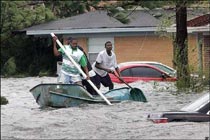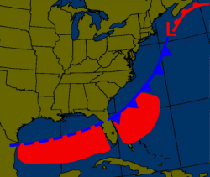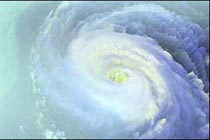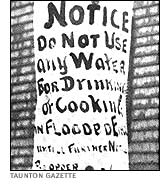| (insert your NIE or newspaper logo here) |
Weekly Online LessonOnline Lesson ArchiveGrade Level: 6-8
|
Living in Hurricane Country
 Hurricane
Katrina hit the Gulf states with devastating force last week, cruising
at 145 miles per hour when it crossed Louisiana's coastline.
Hurricane
Katrina hit the Gulf states with devastating force last week, cruising
at 145 miles per hour when it crossed Louisiana's coastline.
When Katrina hit Florida, it was only a Category 1 hurricane at 80 miles per hour. By Monday, August 29, 2005, when it hit Louisiana, Mississippi and Alabama, it had vaulted to a Category 4.
Katrina's force whipped off rooftops, ripped houses in half, carried boats and cars miles away, damaged off-shore oil rigs in the Gulf, and left thousands of people stranded without food, water or medical care.
New Orleans—a city already sinking toward sea level due to heavy urban development on drained swamp land—was the hardest hit. Flooding blew out bridges and roads, power and communication lines. About 80 percent of the city lies underwater—as much as 20 feet underwater in some places.
Hundreds of residents have died, and that count may rise into the thousands as clean-up and recovery continues over the following weeks.
Meanwhile, thousands of residents remain stranded amid rooftops and other places, awaiting rescue. Refugees are being transported to neighboring counties and states, and health officials fear the spread of disease if clean water isn't delivered more quickly.
Property damage across the region is in the billions of dollars, and gas prices have soared at every pump nationwide.
 And
while Katrina will go down in history as one of the worst disasters
in American history, it is certainly not the last hurricane we'll see.
Experts predict at several more are likely to form in the Atlantic Ocean
before the year's end.
And
while Katrina will go down in history as one of the worst disasters
in American history, it is certainly not the last hurricane we'll see.
Experts predict at several more are likely to form in the Atlantic Ocean
before the year's end.
Even now, Hurricane Maria is busy off Florida's eastern coastline, though meteorologists predict it will lose most of its force before landfall.
In the Philippines, Super Typhoon Nabi is raising havoc, and Typhoon Talim has forced more than 600,000 residents to evacuate Shanghai, China.
Clearly, even with 21st century technology and know-how, humans are, to a large degree, at the mercy of natural forces like hurricanes and other types of devastating storms.
Fortunately, weather researchers and scientists are able to fairly accurately track and predict such events. This ability, for example, allowed a few days for many residents in New Orleans—and other high-risk cities—to flee the area before trouble arrived.
So what conditions create a hurricane, which makes them somewhat predictable? How is a hurricane different from a tropical storm or a typhoon?
Those are a few of the questions you'll investigate during this week's lesson. You'll also compare Katrina's force and effects to a hurricane that devastated northeastern states nearly 70 years ago.
Your Hurricane Guide
 To
begin, let's start with the online guide to Hurricanes
at WeatherWorld 2010.
To
begin, let's start with the online guide to Hurricanes
at WeatherWorld 2010.
As you browse through the guide, you can click each underlined word to review the term's definition in the guide's helper pages.
Look over the introduction, then dive into learning about hurricane Definition and Growth.
From what sources does a hurricane get its energy? Regarding storm development, what is the relationship between wind shear and latent heat? What are some other important factors in a hurricane's Initial Development? What exactly happens during CISK? What kinds of conditions intensify this cycle? What weakens it?
As you'll soon discover, a hurricane goes through three Development Stages. What are some specific differences between a Tropical Depression, a Tropical Storm, and a Hurricane? How is the Saffir-Simpson Scale used to classify hurricane strength?
Next, let's take a closer look at a hurricane's components, including
the Eye,
Eye Wall, Spiral
Bands, and its Pressure
and Winds. Why
do different parts of a hurricane experience different pressures, speeds,
moisture levels, and temperatures?
Why
do different parts of a hurricane experience different pressures, speeds,
moisture levels, and temperatures?
Now that you know how a hurricane is formed, check out what forces are responsible for its Movement. What forces influence how and where a hurricane moves? How is that dependent upon where it forms?
Next, find out what scientists and the government are doing to promote Public Awareness and Public Action in hurricane country. What can people do in advance to prepare for these types of situations? What actions should they take during a hurricane and after it passes? What are the five phenomena related to hurricanes that often cause a lot of Damage?
Okay, so now you know how hurricanes are formed, how and why they move, how people in the hurricane zone can be prepared, but do you also know How They Are Named?
First of all, what do they call hurricanes in the North and South Pacific? What agency created the list of names, and how exactly does the system work?
Get a handle on the Global Activity of tropical cyclones. About how many are reported every year? What geographical area experiences the greatest concentration of activity? How do El Niño conditions affect hurricane frequency? In what way is this related to wind shear?
If you have time and can download and install the VRML plug-in, re-visit the Hurricane Guide's Introduction page and Fly through a 3-D Hurricane!
The Hurricane of 1938
 While many hurricanes occur near the Gulf of Mexico, they also often
hit our northeastern states.
While many hurricanes occur near the Gulf of Mexico, they also often
hit our northeastern states.
Such was the case during the American Experience of The Hurricane of '38, whose devastating force was felt from North Carolina to Vermont.
At this PBS site, check out the Timeline of Storm Disasters in the United States, as well as a summary of Record Breaking Storms, categorized as the Deadliest, the Costliest, and the Most Intense.
When were related agencies, like the Federal Emergency Management Agency and the National Weather Service, created? What happened during the hurricane of 1938?
About how many people died from the Galveston hurricane? When and where did the top four costliest storms occur? Why do you think some of the most intense hurricanes did not result in as much damage or loss of life, compared to some of the less intense ones?
Now, zoom in on the 1938 hurricane using the Map. Track the hurricane's effects on people, from Cape Hatteras, to Long Island, to Providence, to Burlington.
Do you think better forecasting could have helped save lives during this hurricane? What kinds of temporary and permanent damage did the hurricane cause?
 While
property damage can often be repaired or replaced, hurricanes also touch
people on a deep and personal level, making their experiences—good
or bad—memorable for the rest of their lives.
While
property damage can often be repaired or replaced, hurricanes also touch
people on a deep and personal level, making their experiences—good
or bad—memorable for the rest of their lives.
To get a more personal perspective on this event, review some of the Hurricane Footage then read through some of the in-depth insight about the People & Events affected by the 1938 hurricane.
Here, you'll learn about the experiences of Capt. Arthur Small, Benedict Thielen, Harrison McDonald, Helen Joy Lee, and Norman Caswell, and more.
In what specific ways was each person affected by the hurricane? What kinds of details do they seem to remember best?
Lastly, learn more about the Hurricane's Aftermath. How did the challenges of dealing with life after the storm compare with the challenges faced during the storm? In what ways were the hurricane events of 1938 similar to or different from those related to Katrina?
Newspaper Activities
Follow the stories related to Katrina or other hurricanes, typhoons, or cyclones, in issues of The Salt Lake Tribune. Are those in need of emergency assistance getting what they need? Who is in charge of these aid operations? What government or civilian forces have joined recovery efforts? What conditions or issues in the hurricane's aftermath are of the most concern to government officials and to residents of the areas most severely affected? Are meteorologists predicting any more hurricanes? If not, why not? If so, then do they have any theories about where these may occur? What kinds of data support their predictions?
What other locations around the world are facing major storm activity? How are people who live in the affected area and those who live outside of those areas responding to these events? What are some of the personal stories, photos, or video clips people captured and being shared by people who survived the storms, as well as those from people who aided survivors? In what ways are government agencies and residents learning from this year's events to better prepare for future large-scale emergencies?
© Copyright 2005
Learners Online, Inc.
